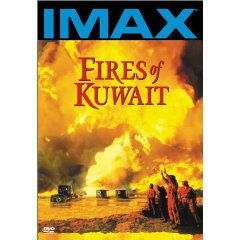 The major events of 20 years ago not only included the fall of the Berlin Wall and communism in Eastern Europe, and the demise of the Soviet Union, but also the invasion of oil-rich Kuwait by its more powerful neighbor, Iraq.
The major events of 20 years ago not only included the fall of the Berlin Wall and communism in Eastern Europe, and the demise of the Soviet Union, but also the invasion of oil-rich Kuwait by its more powerful neighbor, Iraq.
By the fall of 1990, Iraqi dictator Saddam Hussein was easily considered the devil incarnate in much of the western world, while also being hailed as a hero among the masses of the impoverished third world.
Like or loathe him, Hussein was here to stay and intent on making himself a considerable nuisance to the abundant oil fields of the Persian Gulf.
“Fires of Kuwait†(1992), the documentary film directed by David Douglas (Rolling Stones: Live at the Max, 1990), looks at the challenges faced by the oil field firefighters in combating the 700 or so oil field fires, set by the retreating the Iraqi military at the end of the First Gulf War.
Hussein‘s scorched Earth policy, where he wanted to make the oil fields of Kuwait (one of the world’s largest oil reserves) a barren wasteland, since it was the only way for him to get any kind of vengeance against the US-led coalition forces that had comprehensively defeated his military.
If left to its fiery fate, the oil fires would consume five million barrels of oil a day and would not stop for a 100 years, not to mention the pollution of not only the Middle East, but however far, the poisonous smoke, soot and other toxins from the numerous fires the elements could carry.
It needed 27 teams specializing in oil field firefighting from 40 countries, including the United States, Britain and the Soviet Union; and 10,000 people and 1000s of tons of equipment, with only nine months to put out all the oil fires. The largest non-military mobilization in history, was able to complete the operation in significantly less time than the five or 10 years the experts had originally predicted.
The filmmakers mainly follow a Texas-based firefighting team with its dynamite blasting technique to put out the fires and lets their members talk about the Hell on Earth they find themselves in with the darkened skies all around, but also shows them playing baseball when the sun occasionally peeks through on the clearer days.
The different firefighting methods of the various teams is one of the highlights of the documentary. Apart from the blasting technique, there is also the way of putting a hollow tube over the fire and hitting the top of the tube with a blast of cold water to cool the surrounding area, in order to put out the blaze. The most creative method might belong to the Hungarian team who, while recycling a T-34 tank and taking out the gun turret, add a Mig-21 jet engine on top, inject water through it and open the throttle to put out the fire, which they call “the big wind.â€
Originally made as an IMAX film, the 36-minute documentary, narrated by Hollywood character actor, Rip Torn, is still quite engaging even on a normal screen and was rightly nominated for an Academy Award.
The considerable dangers faced by not only the firefighters in fighting the fires but also the filmmakers in shooting the documentary is made abundantly clear in the footage. Not only the unpredictability of the wind swept fires but also the countless Iraqi landmines and coalition bombs strewn all around the oil fields gives the film a sense of dangerous realism that most Hollywood blockbusters would have difficulty replicating.
That alone makes this broadcast an informative and worthwhile experience.

Leave a Reply